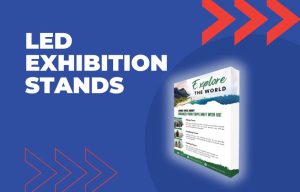Trade shows are a cornerstone of B2B marketing strategies, offering a unique opportunity to showcase products, network, and generate valuable leads. At Discount Displays we surveyed over 100 participants to gauge the current trade show environment and predict future trends. The results provided valuable insights for businesses looking to maximise their presence at trade shows. Read on to discover our must-know trade show stats for 2025.
Key Factors Influencing Trade Show Participation

When it comes to choosing where to exhibit, the majority of respondents (46.7%) believed that the target audience is the most critical factor. With this in mind, exhibitors need to align their trade show participation with the specific demographics of their target and potential customers.
The show’s reputation and past performance are also a higher deciding factor with 22.4% of respondents stating this is a key consideration. Interestingly, cost was a less critical factor with only 6.5% of participants ranking it as the most important factor.
Challenges and Opportunities

Participating in a trade show does not come without its challenges. The most important thing is that you are aware of the challenges so you are prepared to face them. The most significant hurdles identified by respondents include the cost (58.9%), attracting leads (36.4%), and measuring return on investment (34.6%). These challenges highlight the importance of strategic planning, controlled resource allocation, and an effective post-show follow-up process.
31.8% of respondents shared concern over standing out from the competition. However, this saturation highlights opportunities to explore unique targeting and display methods. Whilst your product or service should speak for itself, unique methods may be more effective at capturing attention. Try taking a look at some popular marketing or PR stunts for some inspiration!
Planning and Budget Allocation
Effective trade show participation doesn’t always require significant planning. 58.9% of respondents started their preparations 1-4 months in advance, whilst 12.1% needed 6-12 months to complete all their pre-show planning. A further brave 2.8% started only 1-2 weeks before. Our use of modular systems means that we can offer shorter production times. For these systems, production is only 5-7 working days compared to weeks for traditional stands. With this capability, there is no need to plan so far in advance and last-minute attendance is possible!
For those concerned with the cost of exhibiting – it might be more feasible than you think. However, strict budget allocation is crucial. 40.2% of businesses allocate only 5-15% of their marketing budgets to trade shows and exhibitions, with a further 18.7% allocating less than 5%. This might suggest that either trade shows are not a dominant component of a business’s marketing strategy, or that with smart money management exhibiting doesn’t have to cost the earth.
Objectives and Success Metrics

The survey shed light on the primary objectives of businesses at trade shows. Lead generation (36.4%), followed by brand exposure (29%) was the most common objective amongst exhibitors. An additional 17.8% chose sales whilst 11.3% noted networking was their primary objective.

When asked about how they measure trade show success, 43.9% of exhibitors believed that the number of leads generated is the most insightful metric. Additionally, return on investment (17.8%) and sales (12.1%) were also highlighted as strong measures of success. These figures reflect a balance between immediate financial returns and longer-term relationship outcomes for exhibitors. They also suggest that while sales are important, building a pool of potential customers is seen as the most sustainable strategy.
Social media engagement (7.5%), website traffic (5.6%), and customer feedback (6.5%) were all reported as less important metrics. This also reinforces the ideology that long-term factors are more important than short-term wins. Some respondents also noted the importance of competition entries, feedback, attendance, and the request for contacts in their open-text responses.
The Role of Technology and Social Media

Despite technology playing a pivotal role in today’s society, many exhibitors are wary whether advanced tech has its place at trade shows. The adoption of technologies like virtual reality and interactive displays are still in the early stages with only 19.6% of respondents having used these technologies at their booths. Additionally, only 9.3% of exhibitors are planning to incorporate these in the future, signalling a slower shift towards more immersive trade show experiences than expected.

Social media is a space where businesses are advancing and placing greater importance on their platform presence. A significant 75.7% use social media for pre-event promotion, while 56.1% perform post-event follow-ups.
The most popular platform choice is Facebook (65.4%), followed by Instagram (60.7%). Additionally, LinkedIn is the third most commonly used platform with 53.3% of respondents opting for this online community. Despite the rise of TikTok, businesses are not drawn to this platform with only 8.4% utilising this platform. These figures highlight the growing importance of using digital channels like social media to reach your audience and complement trade show efforts.
Display Materials and Visitor Engagement

When it comes to attracting visitors, traditional advertising materials are still adopted as banners and posters were identified as the most effective by 30% of respondents. This was followed by 24% of respondents who noted that digital displays and product demonstrations are key drivers of visitors. Interactive stations, while engaging and unique, were less commonly noted (15.9%). This indicates that while product interactions offer value, they are not yet a staple for most exhibitors.
Utilising unique displays such as touchscreens and video displays encourages visitors to spend more time at a stand and in turn, get to know the offering better. Previously identified, budget was a high concern for many exhibitors. As a result of this, we have introduced a new hire service for our digital signage range to cut down our exhibitors’ costs and make digital signage more accessible.
When following up on post-trade show leads, 82.2% of exhibitors said they use email. With new email marketing platforms, email is often viewed as the most efficient method of contacting several customers. However, this method can often be less personal.
In contrast, phone calling is used by 53.8% of respondents and social media by 30.8%, with only 14% of exhibitors using direct mail to follow up. When choosing the best method to follow up on leads, it’s important to consider your industry, product offering, and customer base. We suggest contacting current customers to find out what their preferred method would be if they were a potential customer and use this data to build a follow-up strategy.
The Future of Trade Shows

Looking ahead, 57.5% of respondents believe that trade show events will remain in-person. However, 25.5% of respondents are expecting a hybrid model with a mix of virtual and in-person events. Despite some predictions of decreasing importance, only 7.5% of respondents held this view.
When asked about the future importance of trade shows in their company’s marketing strategy, 61.7% of respondents believed it would be just as important as it currently is. A smaller proportion of respondents expect it to become either more important (19.6%) or less important (18.7%). These results lean towards a consensus that exhibiting will continue to play a crucial role in marketing strategies moving forward.
Conclusion
The insights from our survey suggest that while the format of trade shows may evolve, their core value remains intact. Businesses are focused on generating leads, leveraging social media, and balancing costs with the potential return on investment. Understanding and adapting to these trends will be key for businesses to stay ahead of the competition in the changing trade show landscape.
For more guidance, view our resource centre for helpful resources all in one place.
View and download our infographics here:






